T5-AI Acoustic Performance Testing
Last Updated on : 2025-08-22 06:06:02download
This topic provides a step-by-step guide for conducting acoustic performance testing on the T5-AI Voice Box using a Windows system.
Environment setup
Install Python
Go to the official Python website and install v3.8.0 or later.
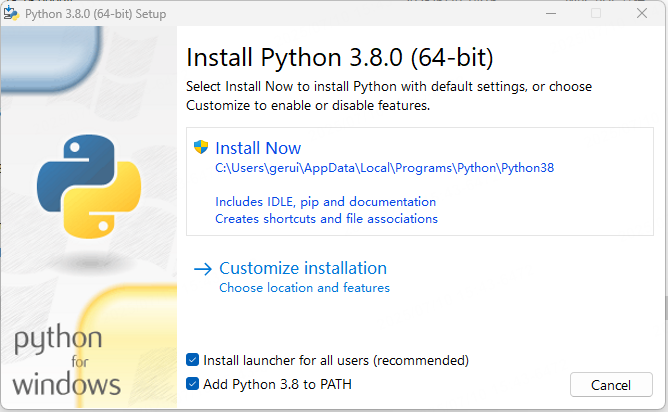
Set system environment variables
-
In the Windows system, choose System Properties > Advanced and click Environment Variables.
-
In the section of System Variables, select Path and click Edit.
-
In the Edit environment variable window, click New. Then, add the paths to
python.exeandpip.exeto the environment variables.
Example paths (replace Username with your actual username):C:\Users\Username\AppData\Local\Programs\Python\Python38\C:\Users\Username\AppData\Local\Programs\Python\Python38\Scripts\
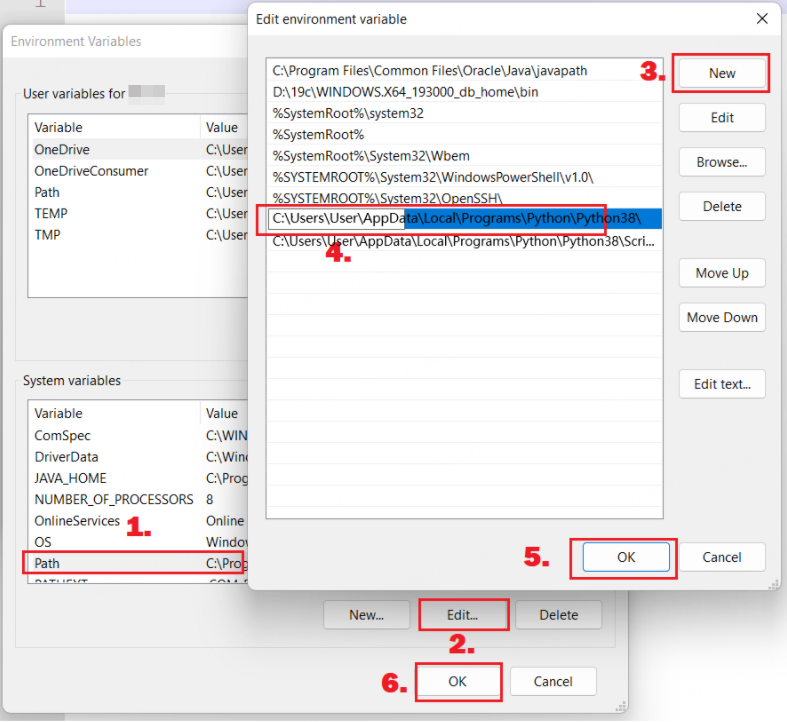
Python installation package
-
Playback/recording (
audio_uart_dump.py) installation package:python -m pip install --upgrade pip pip install pyserial -
Signal analytics (
audio_test.py) installation package:pip install numpy pip install soundfile pip install scipy pip install matplotlib
Install audio analytics software Audacity
Download it from the official Audacity website.
Preparation before testing
DUT firmware
The newly released T5 software supports acoustic testing. The compiled firmware can be used as adapted firmware for the device under test (DUT), for example: tuyaos_demo_ai_toy_QIO_evb1.0.5.bin.
Tool and wiring
Tool: USB to UART converter, used for the communication between PC and DUT via commands.
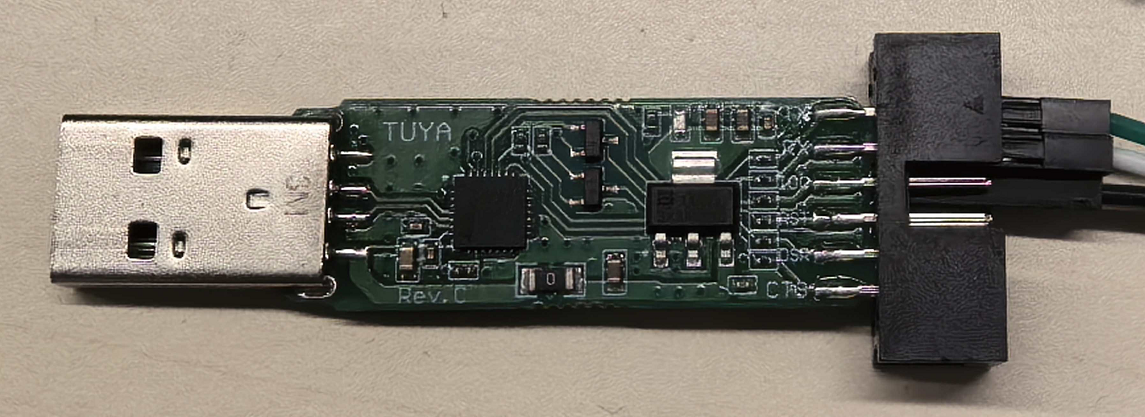
Wiring: Connect the serial port board to the product’s RX0, TX0, and GND.
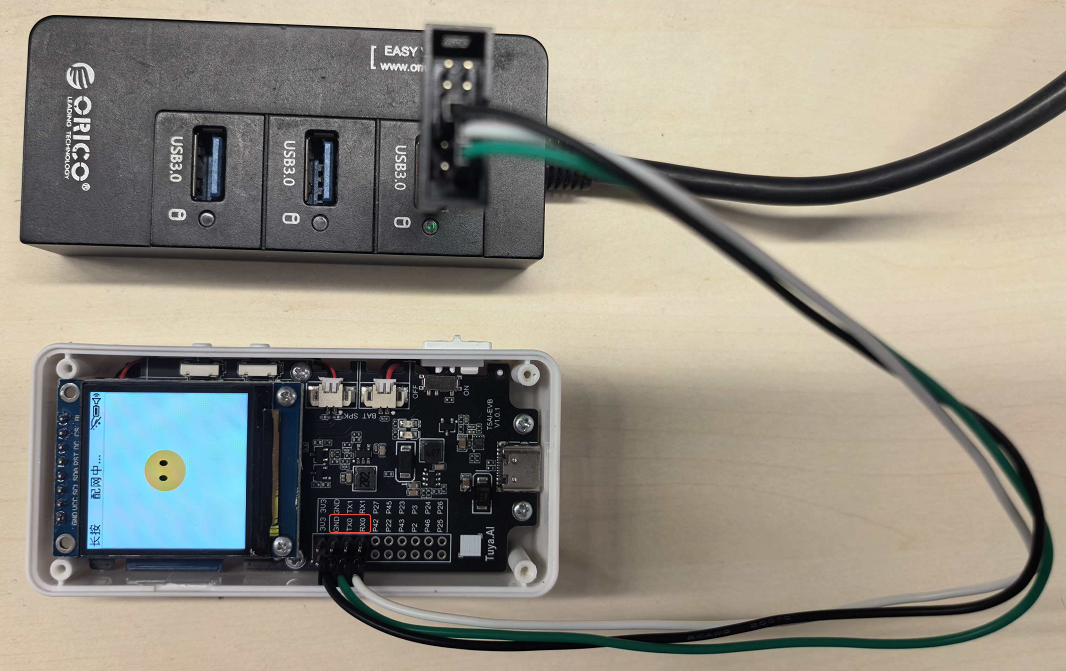
Python script
Refer to the following scripts:
Testing
Start testing
Open the Windows command prompt, go to the audio_uart_dump.py folder, and run the Python script.
d:
cd D:\Test\T5AI-EVB
python audio_uart_dump.py
Example:
C:\Users\gerui>d:
D:\>cd D:\Test\AI_Audio_Test\T5AI\Audio_Test_0804
D:\Test\AI_Audio_Test\T5AI\Audio_Test_0804>python audio_uart_dump.py
Available serial ports:
1. COM17 - Silicon Labs CP210x USB to UART Bridge (COM17)
Select serial port number: 1
Enabled serial port: COM17, baud rate: 2M
Supported commands:
start - Start recording
stop - Stop recording
reset - Reset recording
dump 0 - Dump the microphone channel to dump_mic.pcm
dump 1 - Dump the reference channel to dump_ref.pcm
dump 2 - Dump the AEC channel to dump_aec.pcm
bg 0 - White noise
bg 1 - 1K-0dB (bg 1 1000)
bg 2 - Sweep frequency constantly
bg 3 - Sweep discrete frequency
bg 4 - Minimum single frequency
volume 50 - Set the volume to 50%
micgain 50 - default micgain=70
quit - Quit the program
>
Testing commands
Command description
| Command | Description |
|---|---|
| start | Start recording |
| stop | Stop recording |
| reset | Reset recording |
| dump 0 | Dump the microphone channel to dump_mic.pcm |
| dump 1 | Dump the reference channel to dump_ref.pcm |
| dump 2 | Dump AEC channel to dump_aec.pcm |
| bg 0 | Play white noise |
| bg 1 | Play 1 KHz/0 dB (format: bg 1 1000) |
| bg 2 | Play sweep frequency continuously |
| bg 3 | Play sweep discrete frequency |
| bg 4 | Play minimum single frequency signal |
| volume 50 | Set volume to 50% |
| quit | Quit the program |
Example:
bg 1 500: Play a 500 Hz sine wave signal.volume 70: Set the volume to 70%.
Audio signals
| Command | Description |
|---|---|
| bg 0 | Play white noise at the level of -3 dB for 5 seconds. |
| bg 1 | 1 KHz sine wave signal at the level of 0 dB for 5 seconds. |
| bg 2 | Sweep frequency constantly (7500 Hz to 100 Hz) at the level of -3 dB for 10 seconds. |
| bg 3 | Sweep discrete frequency (7500 Hz to 50 Hz) at the level of -6 dB for 7 seconds. |
| bg 4 | 1 KHz signal at the level of -90 dB for 5 seconds, used to test the device’s noise floor. |
bg 3 has 21 default frequencies. The following table shows the frequencies and durations:
| Frequency | 1000 | 7500 | 5800 | 4500 | 3500 | 2750 | 2150 | 1700 | 1300 | 1000 | 785 |
|---|---|---|---|---|---|---|---|---|---|---|---|
| Duration | 0.5 | 0.3 | 0.3 | 0.3 | 0.3 | 0.3 | 0.3 | 0.3 | 0.3 | 0.3 | 0.3 |
| Frequency | 600 | 475 | 370 | 285 | 255 | 175 | 135 | 100 | 80 | 65 | 50 |
|---|---|---|---|---|---|---|---|---|---|---|---|
| Duration | 0.3 | 0.3 | 0.3 | 0.3 | 0.3 | 0.3 | 0.3 | 0.3 | 0.5 | 0.5 | 0.5 |
bg 3 corresponds to the file Sweep_7500-50Hz-21pt.xlsx.
Acoustic performance testing and analytics
Amplifier output test
Output power, frequency response, noise floor, and total harmonic distortion (THD) tests:
Generate test signals via audio_uart_dump.py, and measure amplifier output signals using an audio analyzer or oscilloscope.
Microphone test
Amplitude, noise floor, frequency response, and THD tests:
In an anechoic chamber, broadcast test signals via an artificial mouth. Record and export the microphone channel audio using audio_uart_dump.py. Then, analyze the audio files in Audacity.
Reference test
Amplitude, noise floor, frequency response, and THD tests:
The DUT plays and records the audio itself. Use audio_uart_dump.py to generate a test signal, record the audio, and dump it as an audio file for the reference channel. Then, analyze the audio files in Audacity.
Import audio files to Audacity
-
In Audacity, choose File > Import > Raw Data.
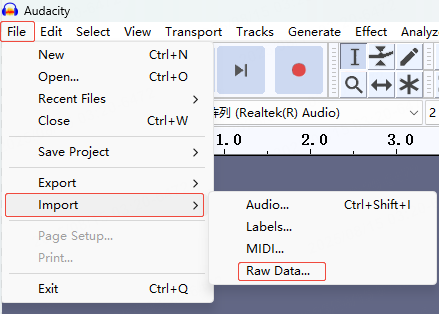
-
In the Import Raw Data window, configure as shown below:
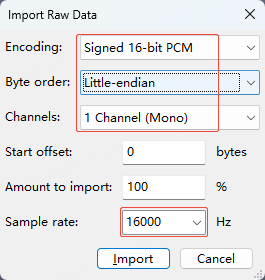
(Optional) Analyze audio signals using audio_test.py
Open the Windows command prompt, go to the audio_test.py folder, and run the Python script. Example:
d:
cd D:\Test\T5AI-EVB\audio_test
python audio_test.py --mic1 test_1k_mic.pcm --ref test_1k_ref.pcm --test_case 1k_single
Description of audio_test.py:
-
Command:
python audio_test.py --mic1 dump_mic.pcm --ref dump_ref.pcm --test_case 1k_single -
Parameters:
Parameter Description mic1 Testing audio file ref Reference audio file test_case Test cases, including 1k_single,white_noise, andsilence -
Each file is associated with specific test items.
File Test item 1K single frequency thdtanddc_offsetWhite noise dc_offset,coherence,clip_detect, anddelay_stabilityMute noise_floor -
Description of test items:
Parameter Description dc_offset Direct current (DC) offset (pass/fail) coherence Correlation between microphone and reference (Closer to 1 is better) noise_floor Noise floor clip_detect Audio clipping detection thd THD (Pass/fail) delay_stability Audio delay stability
Example:
C:\Users\gerui>d:
D:\>cd D:\Test\AI_Audio_Test\T5AI\Audio_Test_0804
D:\Test\AI_Audio_Test\T5AI\Audio_Test_0804>python audio_test.py --mic1 dump_mic.pcm --ref dump_ref.pcm --test_case 1k_single
Start testing
DC offset
dc offset: Pass
dc offset: Pass
Mic1: -0.000052, Ref: -0.000042
Total harmonic distortion (THD)
THD: Pass
THD: Pass
Mic1: 0.0059, Ref: 0.0017
End of test
Is this page helpful?
YesFeedbackIs this page helpful?
YesFeedback





